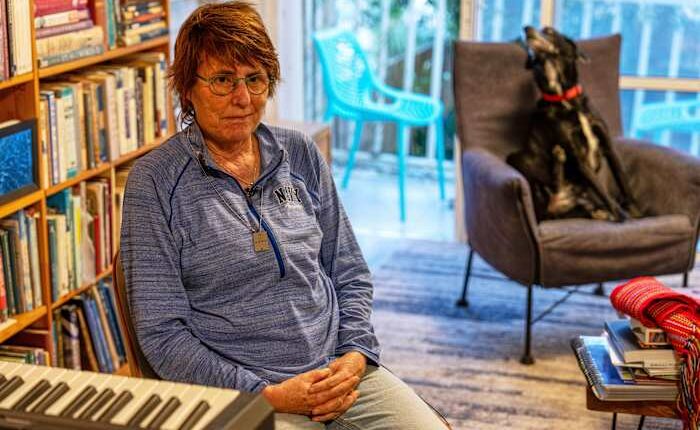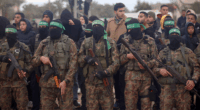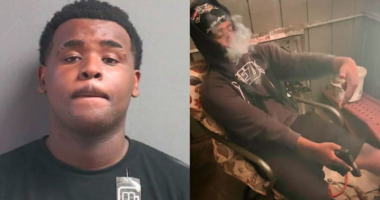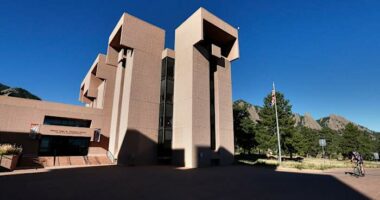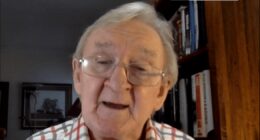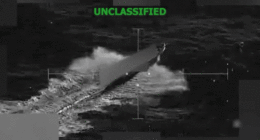Share this @internewscast.com

ZICHRON YAACOV – Tal Hartuv bears a jagged scar among the 18 stab wounds from a vicious 2010 attack near Jerusalem that claimed her friend’s life. Beside the 7-centimeter scar lies a dog tag with the inscription “Our heart is captive in Gaza,” a well-known artifact representing support for a peace deal involving the exchange of Israeli hostages for Palestinian prisoners.
On Friday, amidst celebrations over a ceasefire agreement between Israel and Hamas after prolonged conflict, Hartuv discovered the name Iyad Hassan Hussein Fatafta on a list of Palestinian prisoners to be released. He was among three men who attempted to kill her and were convicted in the murder of her friend Kristine Luken, an American tourist in Israel.
Survivors like Hartuv and those who lost loved ones face a difficult choice during the conflict: Allow the release of those responsible for their suffering and risk further violence, or leave hostages in Gaza to an uncertain fate?
“I can experience excitement and hopefulness that our hostages are being returned,” said Hartuv, who adopted a new name during her recovery. “Yet I can also feel resentment, betrayal, and emptiness. These feelings coexist,” she expressed.
No one from the Israeli government reached out to let her know he would likely be released. She received the list from a journalist.
Come Monday, Hamas is expected to start freeing the remaining 48 Israeli captives in Gaza, with approximately 20 believed alive. Israel plans to release around 2,000 Palestinians, counting senior militants involved in past deadly attacks, along with individuals charged with minor offenses and those held without trial under administrative detention.
‘We need to bring them back’
Back in 2001, a suicide bomber detonated on Bus 37 in Haifa, a northern Israeli city, killing 17, including nine schoolchildren on their way home.
Israel convicted five Palestinians of assisting the bomber. Three were released in 2011 as part of an exchange for Gilad Shalit, an Israeli soldier held in Gaza. A fourth was released during the last ceasefire, earlier this year.
For years, Yossi Zur, whose 17-year-old son, Asaf, was killed in the 2003 Haifa bombing, was a leader campaigning against releases, especially against the 2011 exchange, in which 1,027 Palestinian prisoners were released.
Zur remembers being heartbroken as buses were loaded with convicted militants leaving prison.
Those released in the Shalit deal included Yahya Sinwar, who went on to orchestrate the Oct. 7, 2023, attack that triggered the war. Sinwar became Hamas’ top leader before he was killed by Israeli troops last year.
“It was my failure that I did not manage to protect my son, and now I’m not managing to prevent his murderers from going out of prison,” Zur said.
But when fellow activists reached out to him to protest the ceasefire exchanges in the current war, he declined.
“With the amount of people that were taken on Oct. 7, and with a range of ages, I just came to the conclusion that it’s not going to be worth the fight this time,” he said. “We need to bring them back.”
The worst hostage crisis Israel has faced
Hamas-led militants killed some 1,200 people in the Oct. 7 attack and abducted 251.
Israel’s retaliatory offensive has killed over 67,000 Palestinians, mostly women and children, according to Gaza’s Health Ministry, which does not say how many of the dead were militants.
In a previous ceasefire this year, Israel released nearly 1,800 Palestinians, including around 230 serving lengthy sentences for deadly attacks, in exchange for 25 living hostages and the bodies of eight others. Most prisoners convicted of deadly attacks were deported.
This time, Israel is expected to release around 250 prisoners serving long sentences as well as around 1,700 people seized from Gaza the past two years and held without charge.
After previous releases, joyful crowds welcomed them home, adding to the agony of the families of Israeli victims.
‘I want to try and make Israel a safer place’
Ron Kehrmann’s 17-year-old daughter, Tal, a popular high school senior who loved singing and doodling, was also killed on Bus 37. He still cries whenever he thinks of her.
It feels better to focus on his activism, he says.
He remains staunchly opposed to the release of Palestinian prisoners, saying it’s about deterring attacks.
“I want to try and make Israel a safer place,” he said. The Oct. 7 attack happened “because of the mistake of the government,” in releasing militants for Shalit, he said.
“If a youngster knows that at one point, if he succeeds in killing the Israelis, he will be released, so why shouldn’t he do it?” said Kehrmann. “Israel needs to break the equation of releasing hostages via releasing terrorists.”
A decision to maintain empathy
Since receiving the news of her attacker’s impending release, Hartuv has felt herself sinking into feelings of anger and betrayal. When that happens, she said, she pulls up a photo of a hostage on her phone, or their anguished parents, and looks in their eyes.
“It doesn’t melt me, but it creates that room for empathy and reminds me there’s another side of the coin,” she said.
“That doesn’t dissipate my feeling of anger at the Israeli government, or their sloppiness in not even contacting me, or feelings of betrayal at Western governments who didn’t hold Hamas to account, but it does mollify my sense of injustice to some degree,” she said.
It’s the ability to go back and forth between those heartbreaking stories, holding space for both, that Hartuv wishes more people would emulate. She feels that Israeli discourse has been so fixated on the hostages that people who raise questions about the price of the deal have been pushed aside. She doesn’t want to stop the deal, but after the hostages return, she wants some recognition for the price Israel, and she in particular, had to pay, and for the fear that this could lead to more attacks.
“It would make the release of the hostages so much more magnificent if you understand how necessary this is for Israel, but also how difficult,” she said.
Copyright 2025 The Associated Press. All rights reserved. This material may not be published, broadcast, rewritten or redistributed without permission.
